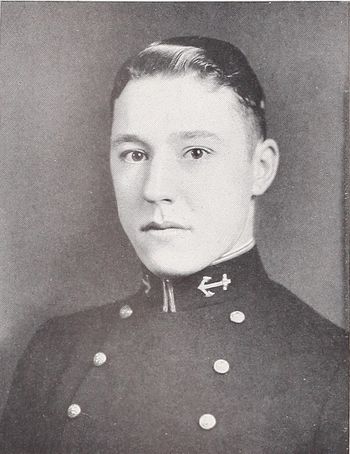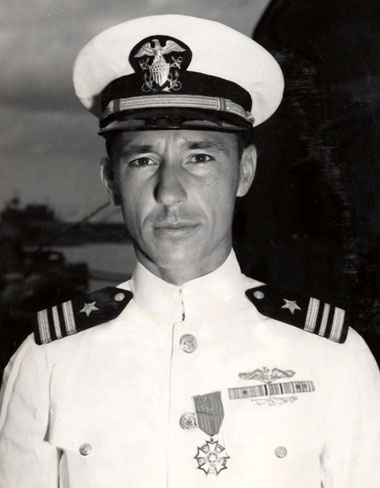THOMAS B. OAKLEY, JR., CDR, USN
Thomas Oakley, Jr. '34
Lucky Bag
From the 1934 Lucky Bag:
THOMAS BENJAMIN OAKLEY, JR.
Staten Island, New York
"Ben" "Oak"
THE great Metropolis of New York never was so honored as when she offered this young man to the services of our country. Tall and rugged would be a good description. This plus a robust build and the boisterous swash-buckling air of the pirates of the Spanish main would have made him the hero of many a novel.
Any sport where one is required to be rough and tough is entirely to his liking. Thus we see his preference for football and water polo, dropping the first because of injuries and continuing the latter with high enthusiasm and marvelous success in the grand honor of being the left-back on Navy's 1333 Collegiate Team.
In his studies he does not tend toward brilliancy but he never has any worries over them which is a happy condition. However, in common sense, he is a match for any.
Ben intends staying in the Service and will, no doubt, make a good leader of men. He is well liked and a man who is readily followed through thick or thin. It would not be hazardous to wager that he will make a good officer since the odds are with him. He achieved his ambitions — an athlete and a clean sleever.
Good luck, Ben.
Water Polo 4, 3, 2, 1. Cross Country 4. Football 4, 3. Expert Rifleman. Clean Sleeve. "N." Black "N"

THOMAS BENJAMIN OAKLEY, JR.
Staten Island, New York
"Ben" "Oak"
THE great Metropolis of New York never was so honored as when she offered this young man to the services of our country. Tall and rugged would be a good description. This plus a robust build and the boisterous swash-buckling air of the pirates of the Spanish main would have made him the hero of many a novel.
Any sport where one is required to be rough and tough is entirely to his liking. Thus we see his preference for football and water polo, dropping the first because of injuries and continuing the latter with high enthusiasm and marvelous success in the grand honor of being the left-back on Navy's 1333 Collegiate Team.
In his studies he does not tend toward brilliancy but he never has any worries over them which is a happy condition. However, in common sense, he is a match for any.
Ben intends staying in the Service and will, no doubt, make a good leader of men. He is well liked and a man who is readily followed through thick or thin. It would not be hazardous to wager that he will make a good officer since the odds are with him. He achieved his ambitions — an athlete and a clean sleever.
Good luck, Ben.
Water Polo 4, 3, 2, 1. Cross Country 4. Football 4, 3. Expert Rifleman. Clean Sleeve. "N." Black "N"
Loss
Ben was lost when USS Growler (SS 215) was sunk by a Japanese surface vessels on November 8, 1944 in the South China Sea. He was the boat's commanding officer.
Other Information
From researcher Kathy Franz:
In May 1939 Thomas married Betty Stark Breeden in the Mission Inn at Riverside, California. They later sailed for Pearl Harbor where he was stationed. His wife was president of Juniors of Ebell of Los Angeles in 1945. (Newspapers.com, Los Angeles Times, 14 May 1939)
In 1930, his father Thomas, who was born in England, was a civil engineer for the City of Staten Island. His mother was Mary Williams, sister Elizabeth, brother John.
His wife was listed as next of kin. He is listed at the Manila American Cemetery and Memorial.
Photographs
Career
From the now-broken link http://www.fleetorganization.com/subcommandersclassyear3.html:
- Duty USS Cachalot (SS-170) 1 Jul 1939 - 1 Nov 1940
- Executive Officer USS Cachalot (SS-170) 2 Jan 1942 - 1 Jul 1942
- Executive Officer USS Tinosa (SS-283) 18 Jan 1943 - Jul 1943
- Captain USS Tarpon (SS-175) 19 Nov 1943 - 15 Apr 1944
- Captain USS Growler (SS-215) 23 Apr 1944 - Nov 1944
- Lieutenant (j.g.) 31 May 1937
- Lieutenant 1 Jul 1941
- Lieutenant Commander (T) 1 Mar 1943
- Commander (T) 1 Feb 1944
From Hall of Valor:
The President of the United States of America takes pride in presenting the Navy Cross (Posthumously) to Commander Thomas Benjamin Oakley, Jr. (NSN: 0-73499), United States Navy, for extraordinary heroism in the line of his profession as Commanding Officer of the U.S.S. GROWLER (SS-215), on the TENTH War Patrol of that submarine during the period 11 August 1944 to 26 September 1944, in enemy controlled waters of the Southwest Pacific. Striking fiercely at a large Japanese convoy in a daring night surface action, Commander Oakley delivered a fast bow attack, sinking a tanker and damaging a freighter, then, swinging hard right under terrific shellfire, shot four stern torpedoes point blank at an aggressive destroyer, exploding the target in billows of smoke. Threatened with depth-charging and under furious surface attack, he remained surfaced while skillfully evading the persistent counterfire and submerged just before dawn to make his escape undamaged. Warned of the approach of a second heavily-escorted convoy, he attacked from dead ahead of the starboard column, firing three down-the-throat shots at a destroyer bearing down on a collision course, executed a sharp maneuver hard left, fired his stern tubes at two overlapping merchantmen to score heavy damage on both, and swung hard left again in time to see the blazing man-of-war sink a short 200 yards off his port side. Undaunted, he cleared the area under heavy fire while still surfaced and, a few hours after daylight, sighted a third destroyer searching the scene of earlier action. Immediately submerging, he rigged for depth-charging, conducted a brilliant close-range periscope attack and plunged deep to register through the GROWLER's hull the shattering concussions of his death-dealing torpedoes as they struck the target and exploded. His superb ship handling and indomitable fighting spirit in achieving this outstanding record reflect the highest credit upon commander Oakley, his gallant ship's company and the United States Naval Service.
Action Date: August 11 - September 26, 1944
Rank: Commander
Company: Commanding Officer
Division: U.S.S. Growler (SS-215)
Legion of Merit
From Hall of Valor:
(Citation Needed) - SYNOPSIS: Commander Thomas Benjamin Oakley, Jr. (NSN: 0-73499), United States Navy, was awarded the Legion of Merit (Posthumously) for exceptionally meritorious conduct in the performance of outstanding services to the Government of the United States as Commanding Officer of the U.S.S. TARPON (SS-175) from 12 December 1943 to 5 January 1944.
General Orders: Bureau of Naval Personnel Information Bulletin No. 348 (March 1946)
Action Date: December 12, 1943 - January 5, 1944
Rank: Commander
Company: Commanding Officer
Division: U.S.S. Tarpon (SS-175)
(From USS Tarpon (SS 175): "Tarpon's next war patrol, a photo reconnaissance of various atolls in the Marshall Islands group from 4 December 1943 to 12 January 1944, was largely uneventful. She did get an opportunity at an inter-island tanker and fired two torpedoes, but both missed and the vessel escaped.")
Full Biography
From Stories Behind The Stars via fold3:
Thomas Benjamin Oakley, Jr. (SN O-073499) was born 27 February 1912 in Staten Island (Richmond Borough), New York. His parents were Thomas B. Oakley, Sr. (1884-1959) and Mary J. Williams (1881-1975). His father, who immigrated to the US in 1886 from England, was a civil engineer for the City of Staten Island. He had a sister Elizabeth and brother John.
Ben graduated from the US Naval Academy on 20 June 1930 and was commissioned an Ensign. He was on the water polo team at the Naval Academy. The 1934 Lucky Bag states that Ben was “well liked and a man who is readily followed through thick and thin.” Some of his early assignments included the USS West Virginia (BB-48), 1934-1936, and USS Williamson (DD-244/AVP-15), 1937-1938. In 1938 he attended Submarine School at Submarine Base, New London, Connecticut. In May 1939, Ben married Betty Stark Breeden in Riverside, California. They later sailed to Pearl Harbor, where he was stationed.
In July 1939 he was assigned to the USS Cachalot (SS-170), a submarine that had been commissioned in December 1933. The 1940 US Federal Census shows Ben and Betty living in Honolulu, Hawaii. The USS Cachalot was in a Pearl Harbor drydock undergoing overhaul on 7 December 1941 when the Japanese attacked. According to various accounts, the Cachalot was not damaged during the attack, and one crew member was injured. On 2 January 1942, Ben became the Executive Officer of the Cachalot. Cachalot conducted its first war patrol from 12 January 1942 to 18 March 1942, departing from Pearl Harbor. Her second patrol was 9 June 1942 to 26 July 1942, departing from Midway and returning to Pearl Harbor.
LT Oakley was assigned as the Executive Officer for the USS Tinosa (SS-283) on 18 January 1943, which was newly commissioned at Mare Island Shipyard. Tinosa arrived in Pearl Harbor on 16 April 1943 and departed for her first war patrol on 3 May 1943. Tinosa returned to Midway on 19 June 1943. Her second war patrol was in July-August 1943, when she returned to Pearl Harbor.
LCDR Oakley became the Commanding Officer of the USS Tarpon (SS-175) on 19 November 1943. Tarpon departed on her tenth war patrol on 4 December 1943. LCDR Oakley was awarded the Legion of Merit for exceptionally meritorious service as Commanding Officer of the U.S.S. Tarpon on this patrol. Following the patrol, Tarpon performed an extended refit until April 1944.
On 23 April 1944, CDR Thomas B. Oakley, Jr. relieved LCDR Arnold F. Schlade as commanding officer of submarine USS Growler (SS-215) at Majuro Atoll, Marshall Islands. The USS Growler was a Gato-class fleet submarine built in Groton Connecticut by the Electric Boat Company. It was commissioned on 20 March 1942. After completing shakedown trials, Growler was underway for Pacific waters in early May 1942, arriving at Pearl Harbor on 31 May.
Growler departed for her ninth war patrol on 14 May 1944, and returned to Pearl Harbor for a refit on 17 July 1944. On 11 August 1944, Growler departed Pearl Harbor for her tenth war patrol. During a stop at Midway Atoll, submarine USS Growler formed a wolfpack with submarines USS Sealion and USS Pampanito with Growler’s captain, CDR Thomas B. Oakley, Jr., in command. The pack was named “Ben’s Busters.” The pack sank seven ships on this patrol. On 26 September 1944, Growler arrived in Freemantle for a refit.
Growler departed Freemantle on 20 October 1944 on her eleventh and final war patrol. The Growler was a member of a wolfpack consisting of USS Hake (SS-256) and USS Hardhead (SS-365). The pack detected an enemy convoy in the South China Sea on the morning of 8 November 1944. Growler closed in for the kill while Hake and Hardhead flanked the convoy. CDR Oakley ordered the wolf pack to attack, but that was the last communication ever heard from Growler. A short time later, Hake noted in her war diary that she heard two explosions of “undetermined character,” and almost simultaneously, the convoy zig-zagged away from Growler’s position. Hardhead heard what sounded like a torpedo explosion followed by three depth charges on the opposite side of the convoy. Hake and Hardhead continued to attack the convoy, sinking the 5,300-ton tanker Manei Maru. Hake endured 16 hours of enemy attacks with some 150 depth charges exploding around her during the battle. After the engagement was complete, Hake and Hardhead attempted to contact Growler continuously for three days, without success. The likely culprits of Growler’s demise were later identified as Japanese destroyer Shigure and escort vessel Chiburi, or another Japanese vessel in the convoy. The possibility also exists, however unlikely, that one of Growler’s own torpedoes made a premature or circular run.
CDR Oakley was awarded the Navy Cross for his performance during the Growlers last patrol. The citation reads: The President of the United States of America takes pride in presenting the Navy Cross (Posthumously) to Commander Thomas Benjamin Oakley, Jr. (NSN: 0-73499), United States Navy, for extraordinary heroism in the line of his profession as Commanding Officer of the U.S.S. GROWLER (SS-215), on the TENTH War Patrol of that submarine during the period 11 August 1944 to 26 September 1944, in enemy controlled waters of the Southwest Pacific. Striking fiercely at a large Japanese convoy in a daring night surface action, Commander Oakley delivered a fast bow attack, sinking a tanker and damaging a freighter, then, swinging hard right under terrific shellfire, shot four stern torpedoes point blank at an aggressive destroyer, exploding the target in billows of smoke. Threatened with depth-charging and under furious surface attack, he remained surfaced while skillfully evading the persistent counterfire and submerged just before dawn to make his escape undamaged. Warned of the approach of a second heavily-escorted convoy, he attacked from dead ahead of the starboard column, firing three down-the-throat shots at a destroyer bearing down on a collision course, executed a sharp maneuver hard left, fired his stern tubes at two overlapping merchantmen to score heavy damage on both, and swung hard left again in time to see the blazing man-of-war sink a short 200 yards off his port side. Undaunted, he cleared the area under heavy fire while still surfaced and, a few hours after daylight, sighted a third destroyer searching the scene of earlier action. Immediately submerging, he rigged for depth-charging, conducted a brilliant close-range periscope attack and plunged deep to register through the GROWLER's hull the shattering concussions of his death-dealing torpedoes as they struck the target and exploded. His superb ship handling and indomitable fighting spirit in achieving this outstanding record reflect the highest credit upon commander Oakley, his gallant ship's company and the United States Naval Service.
On 1 February 1945, Navy Department Communique No. 572 stated, “Growler is overdue from patrol and presumed lost, cause unknown” and the next-of-kin of her officers and crew were notified. All hands, 86 crewmembers including CDR Oakley, were lost. Over the course of World War II, Growler sank 15 enemy vessels for a total of 74,900 tons and damaged seven other vessels for 34,100 tons on her 11 war patrols.
There is a memorial for the crew of the Growler at the Manila American Cemetery and Memorial in the Philippines, which is in Fort Bonifacio, Taguig City, Metro Manila, within the boundaries of the former Fort William McKinley.
CDR Oakley received the Navy Cross, Legion of Merit, Bronze Star Medal, Purple Heart, Combat Action Ribbon, Good Conduct Medal, Expeditionary Medal, American Campaign Medal, Navy and Marine Corps Presidential Unit Citation, Asiatic-Pacific Campaign Medal, and WWII Victory Medal.
He was survived by his wife Betty Breeden Oakley of Los Angeles, California. He also had a son Thomas who was born in April 1942, but he took the surname of his stepfather when his mother remarried.
The "Register of Commissioned and Warrant Officers of the United States Navy and Marine Corps" was published annually from 1815 through at least the 1970s; it provided rank, command or station, and occasionally billet until the beginning of World War II when command/station was no longer included. Scanned copies were reviewed and data entered from the mid-1840s through 1922, when more-frequent Navy Directories were available.
The Navy Directory was a publication that provided information on the command, billet, and rank of every active and retired naval officer. Single editions have been found online from January 1915 and March 1918, and then from three to six editions per year from 1923 through 1940; the final edition is from April 1941.
The entries in both series of documents are sometimes cryptic and confusing. They are often inconsistent, even within an edition, with the name of commands; this is especially true for aviation squadrons in the 1920s and early 1930s.
Alumni listed at the same command may or may not have had significant interactions; they could have shared a stateroom or workspace, stood many hours of watch together… or, especially at the larger commands, they might not have known each other at all. The information provides the opportunity to draw connections that are otherwise invisible, though, and gives a fuller view of the professional experiences of these alumni in Memorial Hall.
July 1934
October 1934
January 1935
April 1935
October 1935
January 1936
April 1936
July 1936
July 1938
October 1939
June 1940
November 1940
April 1941

The "category" links below lead to lists of related Honorees; use them to explore further the service and sacrifice of alumni in Memorial Hall.

